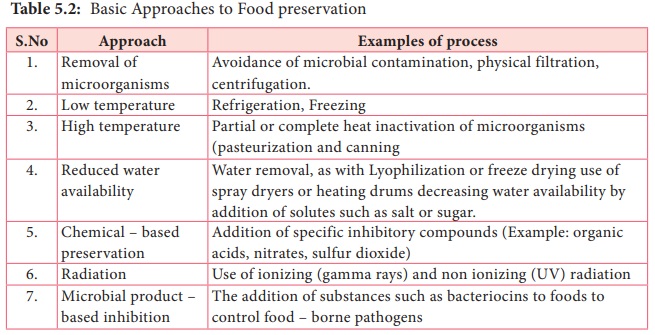Food Microbiology - Food Preservation Methods | 12th Microbiology : Chapter 5 : Food Microbiology
Chapter: 12th Microbiology : Chapter 5 : Food Microbiology
Food Preservation Methods
Food Preservation Methods
Foods can be preserved by a variety of methods. It is vital to eliminate or reduce the populations of spoilage and disease – causing microorganisms and to maintain the microbiological quality of a food with proper storage and packaging. Contamination often occurs after a package or can is opened and just before the food is served. This can proved an ideal opportunity for growth and transmission of pathogens, if care is not taken. Preservation of food is the process by which food is stored by special methods. Cooked or uncooked food can be preserved in different ways to be used later Table 5.2.

Some methods of preservation are:
1. Freezing
Food kept
in a refrigerator remains fresh for some day. Germs do not grow easily in cool
places. We preserve food items, like milk, fruit, vegetable and cooked food by
keeping them in a refrigerator.
2. Boiling
By this
method, we can preserve food for a short period of time. Germs in milk are
killed by pasteurization. It is done by boiling milk for sometimes and then
cooling it quickly.
3. Salting
Add salt
to preserve pickles and fish.
4. Sweetening
Sugar act
as a preservative when added in large quantities. For example, food can be
stored for a long time in the form of jams, jellies and murabbas (Figure 5.2)
by adding sugar.

5. Drying
In this
method, the food items are dried in sun to stop the growth of bacteria in them.
Certain foods, like raw mangoes, fishes, potato chips and papads are preserved
by this method.
6. Canning
In this
method, food is processed and sealed in airtight cans. Food items like
vegetables, seafood, and dairy product are preserved through this method.
Advantages of food preservation
• Germs do not grow easily in preserved food and
make it safe to eat.
• Preservation enables us to enjoy seasonal fruits
like strawberries and mangoes even during the off season.
Disadvantages
• Excess salt and sugar are used in the
preservation of food which is not good for health.
• Some methods of food preservation may lead to loss of nutrients
1. Removal of microorganisms:
Avoidance of microbial contamination, physical filtration, centrifugation.
2. Low temperature:
Refrigeration, Freezing
3. High temperature: Partial
or complete heat inactivation of microorganisms (pasteurization and canning
4. Reduced water availability: Water
removal, as with Lyophilization or freeze drying use of spray dryers or heating
drums decreasing water availability by addition of solutes such as salt or
sugar.
5. Chemical – based preservation: Addition
of specific inhibitory compounds (Example: organic acids, nitrates, sulfur
dioxide)
6. Radiation: Use of ionizing (gamma rays) and
non ionizing (UV) radiation
7. Microbial product – based inhibition: The addition of substances such as bacteriocins to foods to control food – borne pathogens
Infobits.
“Typhoid Fever and Canned Meat”
Minor errors in canning have led to major typhoid outbreaks. In
1964 canned beef produced in South America was cooled, after sterilization with
non chlorinated water. The vacuum created when the cans were cooled drew Salmonella typhi into some of the cans,
which were not completely sealed. This contaminated product was later sliced in
an Aberdeen, Scotland, Food store and the meat slicer became a continuing
contamination source the result was a major epidemic that involved 400 people.
The Salmonella typhi was a South American strain and eventually the contamination was traced to the contaminated
water used to cool the cans. This emphasizes the importance of careful food
processing and handling to control the spread of disease during food production
and preparation.

Principles of Food preservation
In
accomplishing the preservation of foods by the various methods, the following
principles are involved.
1. Prevention or delay of microbial decomposition.
a. By keeping out microorganism (asepsis)
b. By removal of microorganism. Example: Filtration
c. By hindering the growth and activity of microorganism Example: Low
temperature, drying, anaerobic conditions or chemicals.
d. By killing the microorganism Example: Heat or radiation
2. Prevention or delay of self – decomposition of
the food.
a. By
destruction or inactivation of food enzymes Example: Blanching
b. By
prevention or delay of purely chemical reactions Example: Prevention of
oxidation by means of antioxidants.
3. Prevention
of damage because of insects, animals, mechanical causes, etc.
Related Topics